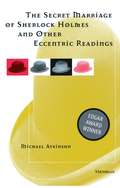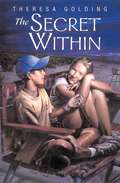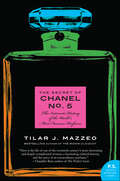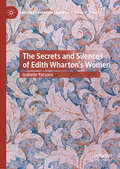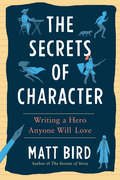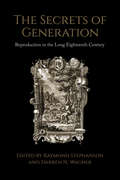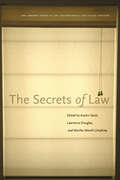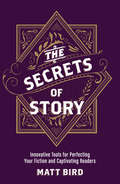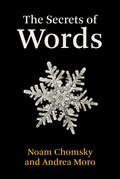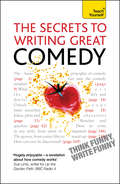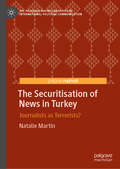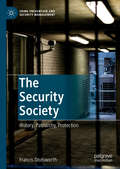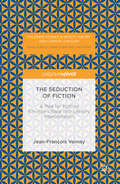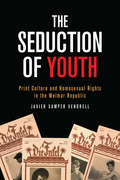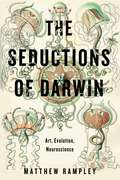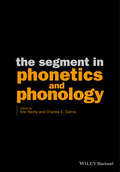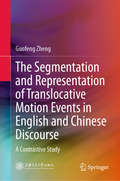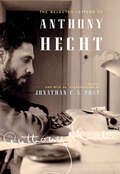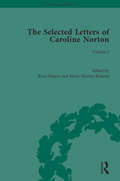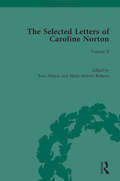- Table View
- List View
The Secret Marriage of Sherlock Holmes
by Michael AtkinsonThe Secret Marriage of Sherlock Holmesis about reading, a process that we take for granted. But Sherlock Holmes, the cultural icon to whose exploits Michael Atkinson gives new readings, became famous by taking nothing for granted. Holmes's adventures can be read in new ways, including ways that he himself would have found startling, but which can give contemporary readers satisfaction. In clear, accessible prose that will engage specialists and lay readers alike, Atkinson engages in "a series of flirtations" with nine of Arthur Conan Doyle's favorite detective fictions, using the tools of modern literary theory, from depth psychology to deconstruction. Bluebeard, the kundalini serpent, and Conan Doyle's mother pop up alongside Jung, Nietzsche, and Derrida as guides to new understandings of these classic stories. Just as Holmes uses treatises on tobacco ash and tattoos to give fresh readings to puzzling facts, Atkinson employs widely different critical strategies to unravel the mysteries of reading itself. "What a delightful book! This is surely the most interesting writing you will ever read about Sherlock Holmes, but it is much more. Michael Atkinson gives us literary criticism at its best: the sheer fun of watching a bold and imaginative reader breathe into well-loved, but well-worn, fictions new and enchanting life. Atkinson's mind races as nimbly as Holmes's own, and he makes the stories our hansom cab through human nature itself. A tour de force!" --Norman N. Holland, author ofMurder in a Dephi Seminar "A book that speaks directly to readers. . . Atkinson sees far beneath the surface of the Sherlock stories to provide fascinating commentary. " --Cincinnati Post "Atkinson demonstrates a love and knowledge of the Holmes stories. . . I would recommend The Secret Marriage of Sherlock Holmes enthusiastically to any lover of the Canon who is prepared to have their perceptions widened. " --Mystery Writers of America Michael Atkinson is Professor of English and Comparative Literature, University of Cincinnati. For additional news, reviews and related Sherlockiana (leaving Press site): Additional information supplied by the author- http://ucaswww. mcm. uc. edu/English/Holmes/ http://ucaswww. mcm. uc. edu/English/Holmes/"
The Secret Within
by Theresa Martin GoldingCarly Chambers has a secret. With her family constantly on the move and father's harsh rules keeping her close to home, it had been an easy secret to keep. Until now. This summer in a beach town on the Jersey coast everything is unraveling. Slipping out of her bedroom window each night, Carly only wants to steal a few hours of freedom on the boardwalk. Then comes the night when she discovers that a stranger has been watching her every move and asking questions about her. Carly is caught in a dangerous game of hiding from the stranger and dodging her abusive father. In this compelling novel by Theresa Martin Golding, Carly Chambers discovers that sometimes the only thing worse than revealing a painful secret--is keeping it.
The Secret of Chanel No. 5: The Intimate History of the World's Most Famous Perfume
by Tilar J. Mazzeo“Who knew that such a tiny bottle housed so many secrets?” —Michael Tonello, author of Bringing Home the BirkinTilar J. Mazzeo, author of the New York Times bestseller The Widow Clicquot (an Amazon Best of the Month book in October 2008) returns with a captivating history of the world’s most famous, seductive, and popular perfume: Chanel No. 5. Mazzeo’s sweeping story of the iconic scent (known as “le monstre” in the fragrance industry) stretches from Coco Chanel’s early success to the rise of the seminal fragrance during the 1950s to the confirmation of its bestseller status in today’s crowded perfume market.“Here is the life of one of the 20th century’s most interesting and deeply complicated women, a fascinating cultural history, and the story of an extraordinary perfume.” —Chandler Burr, New York Times scent critic and author of The Perfect Scent
The Secrets and Silences of Edith Wharton's Women (American Literature Readings in the 21st Century)
by Isabelle ParsonsEdith Wharton’s sensitively observed portraits of women’s lives a century ago resonate into the present day, captivating readers now as they did then. Threaded throughout her accounts is a rich seam of secrets and silences that reveals Wharton’s keen grasp of the realities navigated by women, and her astute use of withholding to tell their stories. This book explores her frequent marshalling of secrets and silences, presented as an integral part of her literary aesthetic, to cast light on her enduring interest in women’s experiences in private and public settings during the early twentieth century.
The Secrets of Character: Writing a Hero Anyone Will Love
by Matt BirdAn insightful and actionable guide to creating a hero that readers will fall in love with, from the author of The Secrets of StoryThe hardest yet most essential element of writing great fiction is character – specifically, creating a central hero who is relatable, compelling, and worth the reader&’s precious time. In this entertaining and practical guide, popular blogger, writing coach and screenwriter Matt Bird breaks down what makes characters embraceable and unforgettable, and presents insider tips and tricks for writers of all levels and genres. Generously packed with examples from popular books and movies analyzed with engaging specificity, this expert guide reveals what makes audiences believe, care, and invest in great characters – and how to bring your own characters vividly to life.
The Secrets of Generation
by Darren Wagner Raymond StephansonFrom theories of conception and concepts of species to museum displays of male genitalia and the politics of breastmilk, The Secrets of Generation is an interdisciplinary examination of the many aspects of reproduction in the eighteenth century.Exploring the theme of generation from the perspective of histories of medicine, literature, biology, technology, and culture, this collection offers a range of cutting-edge approaches. Its twenty-four contributors, scholars from across Europe and North America, bring an international perspective to discuss reproduction in British, French, American, German, and Italian contexts.The definitive collection on eighteenth-century generation and its many milieus, The Secrets of Generation will be an essential resource for studying this topic for years to come.
The Secrets of Law
by Austin Sarat Lawrence Douglas Martha Merrill UmphreyThe Secrets of Law explores the ways law both traffics in and regulates secrecy. Taking a close look at the opacity built into legal and governance processes, it explores the ways law produces zones of secrecy, the relation between secrecy and justice, and how we understand the inscrutability of law's processes. The first half of the work examines the role of secrecy in contemporary political and legal practices-including the question of transparency in democratic processes during the Bush Administration, the principle of public justice in England's response to the war on terror, and the evidentiary law of spousal privilege. The second half of the book explores legal, literary, and filmic representations of secrets in law, focusing on how knowledge about particular cases and crimes is often rendered opaque to those attempting to access and decode the information. Those invested in transparency must ultimately cultivate a capacity to read between the lines, decode the illegible, and acknowledge both the virtues and dangers of the unknowable.
The Secrets of Story: Innovative Tools for Perfecting Your Fiction and Captivating Readers
by Matt BirdYou've just boarded a plane. You've loaded your phone with your favorite podcasts, but before you can pop in your earbuds, disaster strikes: The guy in the next seat starts telling you all about something crazy that happened to him--in great detail. This is the unwelcome storyteller, trying to convince a reluctant audience to care about his story. We all hate that guy, right? But when you tell a story (any kind of story: a novel, a memoir, a screenplay, a stage play, a comic, or even a cover letter), you become the unwelcome storyteller. So how can you write a story that audiences will embrace? The answer is simple: Remember what it feels like to be that jaded audience. Tell the story that would win you over, even if you didn't want to hear it.The Secrets of Story provides comprehensive, audience-focused strategies for becoming a master storyteller. Armed with the Ultimate Story Checklist, you can improve every aspect of your fiction writing with incisive questions like these: Concept: Is the one-sentence description of your story uniquely appealing?Character: Can your audience identify with your hero?Structure and Plot: Is your story ruled by human nature?Scene Work: Does each scene advance the plot and reveal character through emotional reactions?Dialogue: Is your characters' dialogue infused with distinct personality traits and speech patterns based on their lives and backgrounds?Tone: Are you subtly setting, resetting, and upsetting expectations?Theme: Are you using multiple ironies throughout the story to create meaning?To succeed in the world of fiction and film, you have to work on every aspect of your craft and satisfy your audience. Do both--and so much more--with The Secrets of Story. "Matt Bird is a certifiable writing-craft genius." --Cheryl Klein, Senior Editor at Arthur A. Levine Books "What makes this book valuable is how practical Bird is with his advice--every chapter is full of craft tricks and little insights that help take a moment from 'good enough' to 'great!' Consider his 'one-touch rule,' which can instantly add focus and shape to even the smallest scene. This book is full of real tools for real storytellers." --Jonathan Auxier, author of The Night Gardener "The Ultimate Story Checklist is the clearest road map I've seen for helping writers get to what makes a compelling story. I've been sharing Matthew's guide with writers for years." --Andrew Harwell, author of The Spider Ring "Matt Bird has cracked the code on how satisfying stories work. His insights will sharpen your plots, freshen your characters, and liberate your imagination. I always come away from reading Matt Bird feeling inspired and invigorated." --James Kennedy, author of The Order of Odd Fish "Bird's advice raises the bar and encourages 'writing greatness.' It's rare to find such clear and insightful tips about working at the most advanced end of the craft." --Elizabeth Fama, author of Monstrous Beauty "After I followed Matt Bird's writing advice, I received an offer of representation from an agent who called my manuscript 'masterfully structured.' It's a testament to how helpful Bird's advice has been--I've learned more from him than from any other book about writing, and certainly more than from taking any writing class." --Parker Peevyhouse, author of Where Futures End "Matt Bird's blog is possibly my favorite resource on storytelling, maybe even more than Robert McKee's Story. It's really insightful on story structure--detailed without being too rigid, and with a keen appreciation for both big blockbusters and smaller stories." --Emily Horner, author of A Love Story Starring My Dead Best Friend
The Secrets of Words
by Noam Chomsky Andrea MoroTwo distinguished linguists on language, the history of science, misplaced euphoria, surprising facts, and potentially permanent mysteries.In The Secrets of Words, influential linguist Noam Chomsky and his longtime colleague Andrea Moro have a wide-ranging conversation, touching on such topics as language and linguistics, the history of science, and the relation between language and the brain. Moro draws Chomsky out on today&’s misplaced euphoria about artificial intelligence (Chomsky sees &“lots of hype and propaganda&” coming from Silicon Valley), the study of the brain (Chomsky points out that findings from brain studies in the 1950s never made it into that era&’s psychology), and language acquisition by children. Chomsky in turn invites Moro to describe his own experiments, which proved that there exist impossible languages for the brain, languages that show surprising properties and reveal unexpected secrets of the human mind. Chomsky once said, &“It is important to learn to be surprised by simple facts&”—&“an expression of yours that has represented a fundamental turning point in my own personal life,&” says Moro—and this is something of a theme in their conversation. Another theme is that not everything can be known; there may be permanent mysteries, about language and other matters. Not all words will give up their secrets.
The Secrets to Writing Great Comedy
by Lesley BownThe Secrets to Writing Great Comedy will show you how to unlock yourinner anarchist and write fantastic comedy, using a combination ofpractical exercises and creative inspiration. Whatever your preferredgenre, from sitcom to sketch show, you will fi nd guidance on everythingfrom wordplay and visual humour to plots, characters and differentstyles. There is even detailed coverage of how to submit, copyright and,most importantly, get your work noticed.
The Secular Scripture and Other Writings on Critical Theory, 1976?1991
by Northrop Frye Jean Wilson Joseph AdamsonNorthrop Frye's The Secular Scripture was first published in 1976 and was soon recognized as one of his most influential works, reflecting an extensive development of Frye's thoughts about romance as a literary form. This new edition in the Collected Works of Northrop Frye series brings The Secular Scripture together with thirty shorter pieces pertaining to literary theory and criticism from the last fifteen years of Frye's life.Frye's study illuminates the enduring attraction and deep human significance of the romance genre in all its forms. He provides a unique perspective on popular fiction and culture and shows how romance forms have, by their very structural and conventional features, an ability to address both specific social concerns and deep and fundamental human concerns that span time and place. In distinguishing popular from elite culture, Frye insists that they are both ultimately two aspects of the same "human compulsion to create in the face of chaos." The additional late writings reflect Frye's sense at the time that he was working "toward some kind of final statement," which eventually saw the light of day, only months before his death, as Words with Power (1990).
The Securitisation of News in Turkey: Journalists as Terrorists? (The Palgrave Macmillan Series in International Political Communication)
by Natalie MartinThis book examines why Turkey has become infamous as a repressor of news media freedom. For the past decade or so it has stood alongside China as a notorious jailer of journalists – at the same time as being a candidate state of the EU. The author argues that the reasons for this conundrum are complex and whilst the AKP is responsible for the most recent illiberality, its actions should be taken in the wider context of Turkish politics – and the three way battle for power which has been raging between Kemalists, Kurds and Islamists since the republic was founded in 1923. The AKP are the current winners of this tripartite power struggle and the securitisation of journalists as terrorists is part of that quest. Moreover, whilst securitisation is not new, it has intensified recently as the number of the AKP’s political opponents has proliferated. Securitisation is also a means of delegitimising journalism – and neutralizing any threat to the AKP’s electoral prospects – whilst maintaining a democratic façade on the world stage. Lastly, the book argues that whilst the AKP’s securitisation of news began as a means of quashing the reporting of illiberality against wider political targets, since 2016 it has become a target in its own right. In the battle for power in Turkey, journalism is now one of the many losers.
The Security Society: History, Patriarchy, Protection (Crime Prevention and Security Management)
by Francis DodsworthThis book provides a critical engagement with the idea of the ‘security society’ which has been the focus of so much attention in criminology and the social sciences more broadly. ‘Security’ has been argued to constitute a new mode of social ordering, displacing the ‘disciplinary society’ that Foucault saw as characteristic of the liberal era. He saw a ‘control society’ (or ‘risk society’) characteristic of Neo-Liberalism, in which the deviant behaviour of particular individuals, as less important than general attempts to offset risk and reduce harm. Dodsworth argues that much of this literature is extraordinarily present-ist in orientation, denying the long history of attempts to mitigate risk, prevent harm and manage security which have always been a part of the government of order. This book develops a ‘critical history’ of security: a thematic analysis of debates about security and aspects of the security society which puts contemporary arguments and practices in dialogue with the texts and practices of the past. In doing so the book develops a cultural analysis of the meanings of security and the way these meanings have been articulated in particular practical contexts in order to understand how the promise of security has so effectively captured the imagination and channeled the effective engagement of people throughout the modern period.
The Seduction Narrative in Britain, 1747–1800
by Katherine BinhammerEighteenth-century literature displays a fascination with the seduction of a virtuous young heroine, most famously illustrated by Samuel Richardson's Clarissa and repeated in 1790s radical women's novels, in the many memoirs by fictional or real penitent prostitutes, and in street print. Across fiction, ballads, essays and miscellanies, stories were told of women's mistaken belief in their lovers' vows. Katherine Binhammer surveys seduction narratives from the late eighteenth century within the context of the new ideal of marriage-for-love and shows how these tales tell varying stories of women's emotional and sexual lives. Drawing on new historicism, feminism, and narrative theory, Binhammer argues that the seduction narrative allowed writers to explore different fates for the heroine than the domesticity that became the dominant form in later literature. This study will appeal to scholars of eighteenth-century literature, social and cultural history, and women's and gender studies.
The Seduction of Fiction
by Jean-François VernayBy meshing psychology with literary analysis, this book inspires us to view the reading of fictional works as an emotional and seductive affair between reader and writer. Arguing that current teaching practices have contributed to the current decline in the study of literature, Jean-Fran#65533;ois Vernay's plea brings a refreshing perspective by seeking new directions and conceptual tools to highlight the value of literature. Interdisciplinary in focus and relevant to timely discussions of the vitality between emotion and literary studies, particularly within the contexts of psychology, affect studies, and cognitive studies, this book will open up a space in which the formation of our emotions can be openly examined and discussed.
The Seduction of Youth: Print Culture and Homosexual Rights in the Weimar Republic (German and European Studies)
by Javier Samper VendrellA simple man from the provinces, Friedrich Radszuweit merged popular culture, consumerism, and politics as the leader of the League for Human Rights, Germany’s first mass homosexual organization. The Seduction of Youth is the first study to focus on the League and its leader, using his position at the centre of the Weimar-era gay rights movement to tease out the diverging political strategies and contradictory tactics that distinguished the movement. By examining news articles and opinion pieces, as well as literary texts and photographs in the League’s numerous pulp magazines for homosexuals, Javier Samper Vendrell reconstructs forgotten aspects of the history of same-sex desire and subjectivity. While recognizing the possibilities of liberal rights for sexual freedom during the Weimar Republic, the League’s "respectability politics" failed in part because Radszuweit’s own publications contributed to the idea that homosexual men were considered a threat to youth, doing little to change the views of the many people who believed in homosexual seduction – a homophobic trope that endured well into the twentieth century.
The Seductions of Darwin: Art, Evolution, Neuroscience
by Matthew RampleyThe surge of evolutionary and neurological analyses of art and its effects raises questions of how art, culture, and the biological sciences influence one another, and what we gain in applying scientific methods to the interpretation of artwork. In this insightful book, Matthew Rampley addresses these questions by exploring key areas where Darwinism, neuroscience, and art history intersect.Taking a scientific approach to understanding art has led to novel and provocative ideas about its origins, the basis of aesthetic experience, and the nature of research into art and the humanities. Rampley’s inquiry examines models of artistic development, the theories and development of aesthetic response, and ideas about brain processes underlying creative work. He considers the validity of the arguments put forward by advocates of evolutionary and neuroscientific analysis, as well as its value as a way of understanding art and culture. With the goal of bridging the divide between science and culture, Rampley advocates for wider recognition of the human motivations that drive inquiry of all types, and he argues that our engagement with art can never be encapsulated in a single notion of scientific knowledge.Engaging and compelling, The Seductions of Darwin is a rewarding look at the identity and development of art history and its complicated ties to the world of scientific thought.
The Seductions of Darwin: Art, Evolution, Neuroscience
by Matthew RampleyThe surge of evolutionary and neurological analyses of art and its effects raises questions of how art, culture, and the biological sciences influence one another, and what we gain in applying scientific methods to the interpretation of artwork. In this insightful book, Matthew Rampley addresses these questions by exploring key areas where Darwinism, neuroscience, and art history intersect.Taking a scientific approach to understanding art has led to novel and provocative ideas about its origins, the basis of aesthetic experience, and the nature of research into art and the humanities. Rampley’s inquiry examines models of artistic development, the theories and development of aesthetic response, and ideas about brain processes underlying creative work. He considers the validity of the arguments put forward by advocates of evolutionary and neuroscientific analysis, as well as its value as a way of understanding art and culture. With the goal of bridging the divide between science and culture, Rampley advocates for wider recognition of the human motivations that drive inquiry of all types, and he argues that our engagement with art can never be encapsulated in a single notion of scientific knowledge.Engaging and compelling, The Seductions of Darwin is a rewarding look at the identity and development of art history and its complicated ties to the world of scientific thought.
The Seeley Lectures: The Sleeping Sovereign
by Richard TuckRichard Tuck traces the history of the distinction between sovereignty and government and its relevance to the development of democratic thought. Tuck shows that this was a central issue in the political debates of the seventeenth and eighteenth centuries, and provides a new interpretation of the political thought of Bodin, Hobbes and Rousseau. Integrating legal theory and the history of political thought, he also provides one of the first modern histories of the constitutional referendum, and shows the importance of the United States in the history of the referendum. The book derives from the John Robert Seeley Lectures delivered by Richard Tuck at the University of Cambridge in 2012, and will appeal to students and scholars of the history of ideas, political theory and political philosophy.
The Segment in Phonetics and Phonology
by Eric Raimy Charles E. CairnsThe Segment in Phonetics and Phonology unravels exactly what the segment is and on what levels it exists, approaching the study of the segment with theoretical, empirical, and methodological heterogeneity as its guiding principle. A deliberately eclectic approach to the study of the segment that investigates exactly what the segment is and on what level it exists Includes new research data from a diverse range of fields such as experimental psycholinguistics, language acquisition, and mathematical theories of communication Represents the major theoretical models of phonology, including Articulatory Phonology, Optimality Theory, Laboratory Phonology and Generative Phonology Examines both well-studied languages like English, Chinese, and Japanese and under-studied languages such as Southern Sierra Miwok, Päri, and American Sign Language
The Segmentation and Representation of Translocative Motion Events in English and Chinese Discourse: A Contrastive Study
by Guofeng ZhengThis book provides a systematic, contrastive analysis of the segmentation and representation of English and Chinese Translocative Motion Events (TMEs), which possess Macro-Event Property (MEP). It addresses all the issues critical to understanding TMEs in English and Chinese, from event segmentation, MEP principles and the conceptual structure of TMEs and their constituents, to the representation of Actant, Motion, Path and Ground. The book argues that the corpus-based alignment for the TME segmentation in both languages, the parameters of Actant, Motion, Path and Ground and their relevant statistical description are particularly important for understanding English and Chinese TMEs. The linguistic materialization of Actant, Ground, Path and Motion, together with a wealth of tables and figures, offers convincing evidence to support the typological classification of English and Chinese. The book’s suggestions regarding the Talmyan bipartite typology and Bohnemeyer’s MEP contribute to the advancement of TME studies and language typology, and help learners to understand motion events and English-Chinese typological similarities and differences.
The Seizure of Power
by Czeslaw Milosz Celina WieniewskaNovel by the Nobel Prize winner for Literature about the month in 1944 when Nazi rule over Europe was crumbling and the Red Army pushed into Poland to meet the Western Allies on the Elbe.
The Selected Letters of Anthony Hecht
by Anthony HechtSpanning seven decades, these often intimate, brilliantly astute letters by the eminent poet Anthony Hecht reflect a body of work that influenced the history of twentieth-century American poetry.Pulitzer Prize-winning poet Anthony Hecht (1923–2004) was known not only for his masterful control of form and language but also for his wit and humor. With the help of Helen Hecht, the poet’s widow, Jonathan F. S. Post combed through more than 4,000 letters to produce an intimate look into the poet’s mind and art across a lifetime. The letters range from Hecht’s early days at summer camp to college at Bard, to the front lines of World War II, to travels abroad in France and Italy, to marriage, and to fame as a poet and critic. Along the way, Hecht corresponded with well-known poets such as John Hollander, James Merrill, Anne Sexton, and Richard Wilbur. Those interested in the lives of contemporary poets will read these highly personal letters with delight and surprise.
The Selected Letters of Caroline Norton: Volume I (The Pickering Masters)
by Ross Nelson; Marie Mulvey-RobertsThis is the first volume of a three volume collection of the correspondence of Caroline Norton, covering the period July 1828-Deember 1837. The collection also includes an introduction and five commentaries by the editor, contextualising and embedding Caroline’s literary and political achievements within the narrative of her letters.
The Selected Letters of Caroline Norton: Volume II (The Pickering Masters)
by Ross Nelson; Marie Mulvey-RobertsThis is the second volume of a three volume collection of the correspondence of Caroline Norton, covering the period January 1838-November 1857. The collection also includes an introduction and five commentaries by the editor, contextualising and embedding Caroline’s literary and political achievements within the narrative of her letters.
